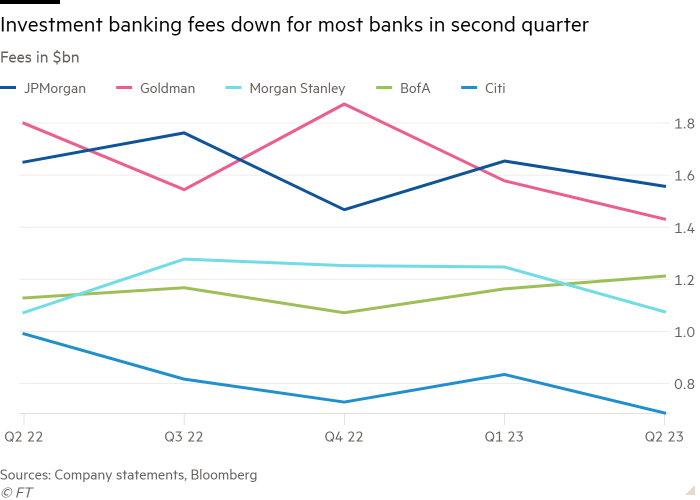Goldman Sachs has slumped to its lowest quarterly profit in three years, as a costly retreat from consumer banking deepened the pain of the industry-wide slowdown in deals and trading.
Net income plunged by almost two-thirds to $1.1bn in the second quarter, down from $2.8bn a year earlier, Goldman said on Wednesday.
The Wall Street bank has been hit hard by the prolonged weakness in investment banking and trading, its historic profit engines. Investment banking revenues tumbled 20 per cent to $1.4bn while revenues from trading equities, fixed income, currencies and commodities fell 12 per cent to $5.7bn.
An already testing quarter was also marred by several charges, including a $504mn writedown on GreenSky, an online lender acquired in 2021 as part of chief executive David Solomon’s ill-fated push into consumer banking. Goldman also recorded a $485mn impairment on its real estate investments.

While the bank’s $1.1bn in profit for the quarter matched analysts’ expectations, the slump in earnings highlights the pressure facing Solomon, who is mired in the most challenging period of a tenure that began in 2018.
Last year, Solomon pivoted away from the group’s much-heralded expansion into consumer banking, re-emphasising Goldman’s investment banking and trading businesses just as both face the toughest conditions in several years.
“I remain fully confident that continued execution will enable us to deliver on our through-the-cycle return targets and create significant value for shareholders,” Solomon said on Wednesday.
The drop in investment banking revenues matched analysts’ expectations but was steeper than the 5.6 per cent fall at JPMorgan. Investment banking revenues, meanwhile, were flat at close rival Morgan Stanley and up 7 per cent at Bank of America. They fell 30 per cent at Citigroup.

Trading revenues are still above pre-pandemic levels but the business is coming off a boom due to volatile financial markets during the pandemic, central banks raising interest rates and Russia’s war with Ukraine.
Within Goldman’s trading division, revenues from equities edged up 1 per cent to almost $3bn, surpassing estimates of $2.4bn. That helped drive total revenues for the quarter to $10.9bn, down 8 per cent from a year earlier, but better than expected.
Goldman’s fixed-income and commodities traders fared less well, with revenues falling 26 per cent to $2.7bn, trailing the $2.8bn analysts had pencilled in.

Goldman’s asset and wealth management division, the cornerstone of Solomon’s efforts to diversify Goldman’s business, reported revenue of $3bn, down 4 per cent from the same period last year and lagging analysts’ estimates of $3.5bn. Earnings were hit by the impairments tied to real estate investments.
Goldman’s return on equity, a critical measure of profitability, was 4 per cent for the quarter, well below peers and far off the bank’s own target of 14-16 per cent.
The bank’s shares, which have fallen about 2 per cent this year, edged down 1.5 per cent in pre-market trading in New York. Analysts had been unusually divided over how bad the quarter would be for the bank.
Additional reporting by Stephen Gandel
This article has been amended to clarify that Goldman’s second-quarter profits are the lowest since 2020.
